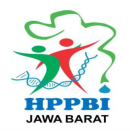Public Cemetery’s Potency as The Source of Proteolytic Bacteria
DOI:
https://doi.org/10.25134/quagga.v15i2.44Keywords:
Bakteri proteolitik; indeks proteolitik; tanah TPUAbstract
Cemetery is an area provided for burial and acts as an active bodies disposal site. One group of bacteria which is likely to be found with a high population is the proteolytic bacteria because the human body is made up of 46.85% protein. The exploration of proteolytic bacteria from public cemetery in Indonesia has not been conducted as so this research is necessary and become the main objective of this study. This research is a non-experimental study to isolate soil bacteria from Pracimaloyo public cemetery in the district of Kartasura. Skim Milk Agar (SMA) is used as selective media. Proteolytic capacity was determined using the proteolytic index (PI). Potential proteolytic bacteria isolates were identified based on morphology features and PI values > 2 were isolated from P23 and P22 isolates. Bacterial proteolytic isolates are dominantly colonies of white to yellowish with irregular and circular shapes. Gram-staining results indicated that bacterial isolates with proteolytic abilities are belong to Gram-negative bacili bacteria. The highest PI value of bacterial isolates exhibited by P23 isolates and possibly belong to the genus Bacillus. The study has discovered that Pracimaloyo holds the potential as a proteolytic soil bacteria habitat dominated by the Gram-negative group.
References
Agus, C., Faridah, E., Wulandari, D., & Purwanto, H. 2014. Peran Mikroba Starter dalam Dekomposisi Kotoran Ternak dan Perbaikan Kualitas Pupuk Kandang ( The Role of Microbial Starter in Animal Dung Decomposition and Manure Quality Improvement ) Fakultas Kehutanan UGM , Jalan Agro Bulaksumur Yogyakarta 55281 KP4 U. Jurnal Manusia Dan Lingkungan, 21(2), 179–187.
Dent, B. B., Forbes, S. L., & Stuart, B. H. 2004. Review of Human Decomposition Processes in Soil. Environmental Geology, 45(4), 576–585.
Fitriana, N., & Asri, M. T. 2021. Aktivitas Proteolitik pada Enzim Protease dari Bakteri Rhizosphere Tanaman Kedelai (Glycine max L.) di Trenggalek. LenteraBio : Berkala Ilmiah Biologi, 11(1), 144–152.
Forbes, R. M., Cooper, A. R., & Mtchell, H. H. 1953. The Composition of the Adult Human Body as Determined by Chemical Analysis. The Journal of Biological Chemistry, 203(1), 359–366.
Hastuti, S.U., Febriani, S., Putri, M. A. A. 2017. Identifikasi dan Penentuan Indeks Hidrolisis Protein pada Bakteri Proteolitik dari Tanah Mangrove di Margomulyo, Balikpapan. Proceeding Biology Education Conference, 14(1), 265–270.
Ibrahim, A. S. S., Al-Salamah, A. A., Elbadawi, Y. B., El-Tayeb, M. A., & Shebl Ibrahim, S. S. 2015. Production of Extracellular Alkaline Protease by New Halotolerant Alkaliphilic Bacillus sp. NPST-AK15 Isolated from Hyper Saline Soda Lakes. Electronic Journal of Biotechnology, 18(3), 236–243.
Li, Q., Yi, L., Marek, P., & Iverson, B. L. 2013. Commercial Proteases: Present and Future. FEBS Letters, 587(8), 1155–1163.
Mahdiyah, D. 2015. Isolasi Bakteri dari Tanah Gambut Penghasil Enzim Protease. Jurnal Pharmascience, 2(2), 73.
Majgier, L., Rahmonov, O., & Bednarek, R. 2014. Features of Abandoned Cemetery Soils on Sandy Substrates in Northern Poland. Eurasian Soil Science, 47(6), 621–629.
Ningsih, H. 2021. Pengantar Bioteknologi (J. Simarmata (ed.); 1st ed.). Yayasan Kita Menulis.
Rizaldi, R., Setyantini, W. H., & Sudarno, S. 2018. Isolasi dan Karakterisasi Bakteri Proteolitik yang Berasosiasi dengan Lamun (Enhalus acoroides) di Pantai Bama, Taman Nasional Baluran, Situbondo, Jawa Timur [Isolation and Characterization Proteolytic Bacteria which is Associated with Sea Grass (Enhalus acoroides) in Bama Beach, Baluran National Park, Situbondo, East Java]. Jurnal Ilmiah Perikanan Dan Kelautan, 10(1), 8.
Susanti, E., Tirta, S., Paramitha, A., Lutfiana, N., & Malang, U. N. 2019. Seleksi Bakteri Proteolitik dari Pangan Fermentasi Lokal Indonesia sebagai Sumber Protease untuk Produksi. MSOpen Book Chapter, 78–92.
Utomo prio, A. ., & Shovitri, M. 2014. Bakteri Tanah Pendegradasi Bahan Organik Desa Talango, Pulau Poteran, Sumenep. Jurnal Sains Dan Seni ITS, 2(3), 80–83.
Winarni, S. 2018. Etika, Kaidah-Kaidah Agama yang berhubungan dengan Kesehatan.
Yahdiyani, N., Hidayatulloh, A., & Nurhayati, L. S. 2021. Potensi Isolat Bakteri Proteolitik dari Proses Pembuatan Pupuk Organik sebagai Starter Pengolahan Limbah Peternakan. Jurnal Teknologi Hasil Peternakan, 2(1), 17.

















